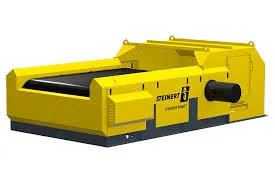

ნოე . 01, 2024 02:14 Back to list
Understanding Aluminium Eddy Current Separation
Eddy current separation is an advanced technique used in the recycling industry to separate non-ferrous metals, particularly aluminium, from other materials. This method leverages the principles of electromagnetic induction, allowing for efficient and effective sorting of aluminium from other metals and contaminants.
The process begins with the introduction of a conductive material, such as shredded aluminium, into an eddy current separator. The separator typically consists of a rotating magnetic field, generated by a series of permanent magnets or electromagnets. When the conductive material passes through this magnetic field, electrical currents, known as eddy currents, are induced within the material.
Understanding Aluminium Eddy Current Separation
As the aluminium passes through the eddy current separator, the induced repulsive force causes the aluminium to separate from non-conductive materials and less conductive metals. This separation process effectively sorts the aluminium into a designated area, allowing for the recovery of pure aluminium that can be processed and recycled.

One of the key advantages of eddy current separation is its ability to handle various types of materials without the need for extensive pre-processing. Unlike traditional separation methods that may require manual sorting or crushing, eddy current separators can effectively process mixed waste streams. This capability not only reduces the labor involved but also increases the speed and efficiency of the recycling process.
Moreover, as the world moves towards more sustainable practices, the recycling of aluminium has gained significant importance. Aluminium is a valuable resource due to its lightweight, strength, and resistance to corrosion. Recycling aluminium saves approximately 95% of the energy required to produce new aluminium from raw ore, making eddy current separation a critical component in enhancing recycling efficiency.
However, it is essential to optimize the design and operation of eddy current separators to improve their efficiency further. Advances in technology, including the development of more powerful magnets and sophisticated sorting algorithms, have enhanced the performance of these systems. As these technologies evolve, the ability to separate smaller aluminium particles and improve recovery rates continues to expand.
In conclusion, aluminium eddy current separation is a pivotal technology in the recycling industry, enabling the efficient extraction of valuable aluminium from waste materials. Its principles leverage electromagnetic induction to isolate conductive metals, providing a fast and effective solution to metal separation. As the focus on recycling intensifies globally, understanding and improving upon eddy current separation systems will be crucial in promoting sustainable practices and reducing waste in our environment. The future of aluminium recycling looks promising, with further advancements poised to enhance recovery rates and efficiency even more.
Latest news
Troubleshooting Common Eddy Separator Problems
NewsJul.04,2025
The Role of Metal Recycling Plants in Circular Economy
NewsJul.04,2025
The Impact of Recycling Line Pickers on Waste Management Costs
NewsJul.04,2025
Safety Features Every Metal Shredder Should Have
NewsJul.04,2025
How Industrial Shredders Improve Waste Management Systems
NewsJul.04,2025
How Cable Granulators Contribute to Sustainable Recycling
NewsJul.04,2025